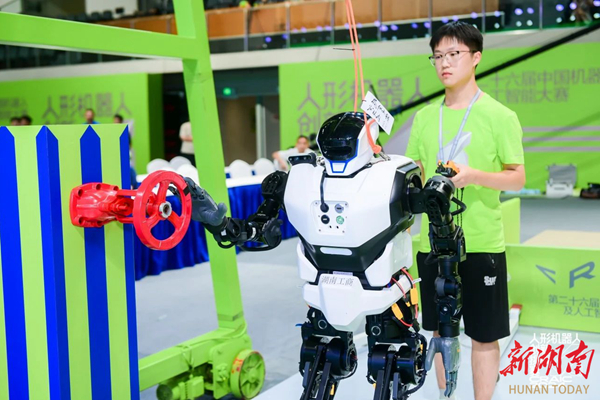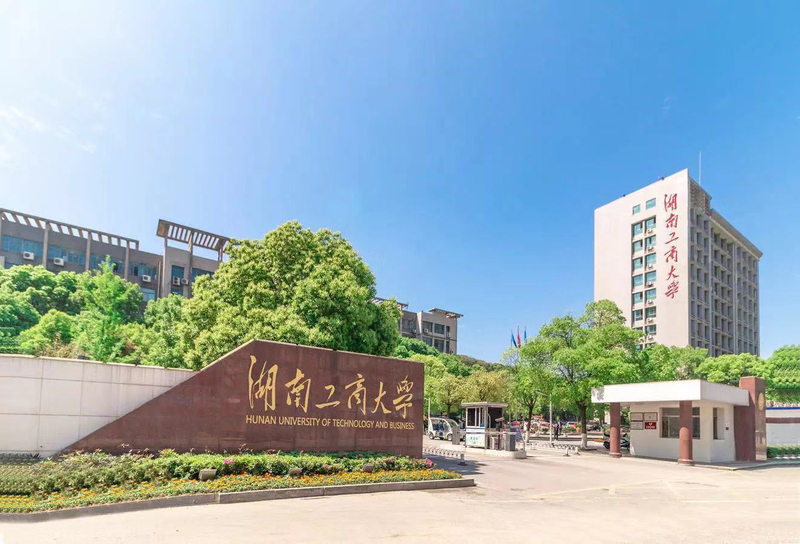[Hunan Today] From Simulated Scenarios to Real-world Applications, HUTB Robotics Team Wins National Championship
2024-10-01
Hunan Daily, August 30 (All Media Reporter Yu Rong) The robot, using large model language recognition instructions, employed 38 motors in its body and 10 joints to perform complex actions, such as walking on gravel roads, opening doors, and handing water… Recently, at the 26th China Robotics and Artificial Intelligence Competition finals, the humanoid robot from the HUTB team demonstrated exceptional motion balance and advanced algorithm matching capabilities, winning the national championship.

According to the introduction, the university won a total of 5 first prizes, 7 second prizes, and 5 third prizes in this competition. Among them, the university secured national championships in both the humanoid robot (physical competition) and the quadruped rapid logistics (robot dog) events, showcasing the university's strong capabilities in the fields of robotics and artificial intelligence.
In recent years, the university has aligned itself with the strategic priorities of the country under the visionary leadership of the Party Committee. By leveraging the National Center for Basic Science project, Xiangjiang Laboratory and other high-caliber scientific and technological innovation platforms, the university has been vigorously developing new engineering programs. Also, the university has been experimenting with talent development modes featuring "Digital Intelligence+" "Green+" and "Artificial Intelligence+". By implementing programs such as the "Xiangjiang Academy - Hong Class", the "Academician Elite program", and the "Major + Micro-Major" programs, the university focuses on the fields of robotics and artificial intelligence. The university integrates cutting-edge technologies and research projects into its talent development system, co-builds and shares a first-class artificial intelligence and advanced computing laboratory, and explores a "project-based practical + competition integration" teaching model. This approach has significantly fostered interdisciplinary and innovative talents, yielding notable results.

Since March of this year, the university has organized over 70 students majoring in artificial intelligence. With the support of major projects like the humanoid robot (embodied intelligence) program at Xiangjiang Laboratory, faculty and students have worked tirelessly for five months, conducting in-depth research in the fields of robot control and artificial intelligence algorithms. They have continuously innovated algorithm models and optimized various technical parameters. Each participating team overcame numerous challenges in events such as humanoid robots, urban autonomous driving, robot soccer, and intelligent pharmacy robots. Through diligent study and hard work, they persevered and ultimately achieved excellent results in the finals after successfully navigating university, provincial, and national preliminary rounds.
CRAIC, which began in 1999, is a longstanding and widely influential national academic competition that has cultivated a large number of hands-on, innovative, and collaborative interdisciplinary talents in our country. This year, it attracted nearly a thousand universities, including Tsinghua University, Peking University, and Harbin Institute of Technology, with over 10,000 students participating. The competition closely mirrors real-world scenarios, and has created a number of "firsts"in its design. This is the first competition to transition from simulated to authentic domestic and specialized application scenarios. It is also the first competition in fully automated task management, and the first to introduce generative large-model LLM task planning assessment in a competition. By incorporating industrial and real-life application scenarios into the humanoid robot competition, the event aims to capitalize on the strengths of diverse research domains, collaboratively addressing complex challenges in future universal application scenarios. This would facilitate the transition of humanoid robots from virtual to real-world applications and from technological innovation to industrial application, expediting the mass production and widespread adoption of these robots.
Since the HUTB team began participating in 2019, it has consistently won the national first prize for six consecutive years, highlighting the outstanding talent development outcomes in its robotics and artificial intelligence programs.
Link









